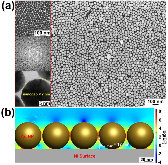Probing Electrolyte Solvents at Solid/Liquid Interface Using Gap-Mode Surface-Enhanced Raman Spectroscopy
Understanding the aprotic solution structures at the immediate vicinity of solid/liquid interface (SLI) is critically important for next generation lithium ion battery development. Yet, it is still challenging to investigate the carbonate chemical profiles close to the diffuse layer (about 10 nm) of the electrical double layer at SLI due to the lack of a ultrahigh surface sensitive tool. In this work, we demonstrate the structures of commonly used carbonate solvents (ethylene carbonate (EC) and diethyl carbonate (DEC)) and a carbonate additive (fluoroethylene carbonate (FEC)) in a commercial Li-ion battery electrolyte can be determined at ∼17 nm above the electrode surface. This is only enabled by a nanogap surface-enhanced Raman spectroscopy (SERS) technique based on a monolayer gold nanoparticle (Au NP) ensemble. The SERS enhancement factor (EF) of those carbonates was found to depend on the molecular polarizability, with the maximum EF at ∼105 found for EC and FEC. Despite their alike chemical structures, this monolayer Au NP SERS substrate is fully capable of discrimiating the different Raman finger prints of EC and FEC. Compared to EC, several vibration modes in FEC, such as C-C skeletal deformation, ring breathing band and C=O stretching band, shift to higher frequencies because of the displacement of a hydrogen atom by a much heavier fluorine atom in a methylene bridge. This counterintuitive observation against the commonly used “ball and spring” model in vibrational spectroscopy is mostly due to the increased bond strength in the FEC ring versus that of EC. A second order empirical polynomial best describes the correlation between the SERS band integration of EC or DEC molar concentration. Furthermore, our findings open up new opportunities for in-depth understanding of the electrolyte molecular vibrational behaviors at direct solid/liquid interface and developing advanced electrolytes for next generation lithium-ion batteries.
- Research Organization:
- Energy Frontier Research Centers (EFRC) (United States). Fluid Interface Reactions, Structures and Transport Center (FIRST); Oak Ridge National Laboratory (ORNL), Oak Ridge, TN (United States)
- Sponsoring Organization:
- USDOE Office of Energy Efficiency and Renewable Energy (EERE), Office of Sustainable Transportation. Vehicle Technologies Office (VTO); USDOE Office of Energy Efficiency and Renewable Energy (EERE)
- Grant/Contract Number:
- AC05-00OR22725
- OSTI ID:
- 1491062
- Alternate ID(s):
- OSTI ID: 1526393
- Journal Information:
- Journal of the Electrochemical Society, Journal Name: Journal of the Electrochemical Society Vol. 166 Journal Issue: 2; ISSN 0013-4651
- Publisher:
- The Electrochemical SocietyCopyright Statement
- Country of Publication:
- United States
- Language:
- English
Web of Science
Similar Records
Electrolyte Solvation Structure at Solid/Liquid Interface Probed by Nanogap Surface-Enhanced Raman Spectroscopy
Fluoroethylene Carbonate Induces Ordered Electrolyte Interface on Silicon and Sapphire Surfaces as Revealed by Sum Frequency Generation Vibrational Spectroscopy and X-ray Reflectivity










